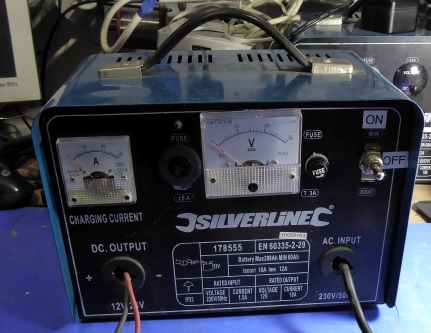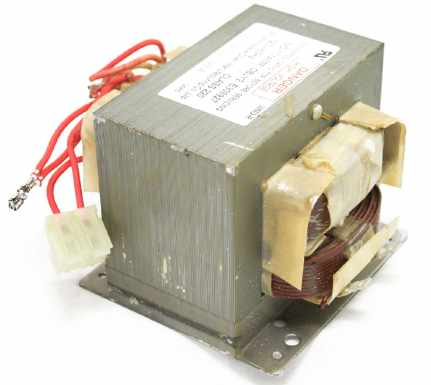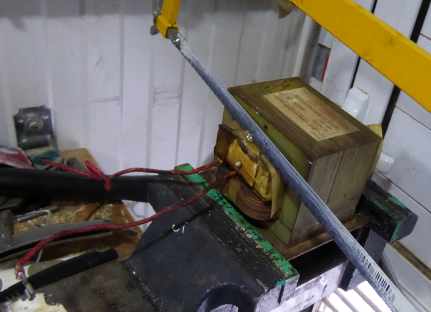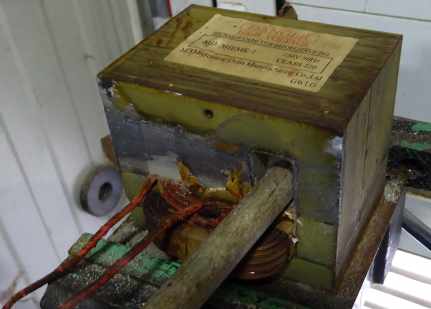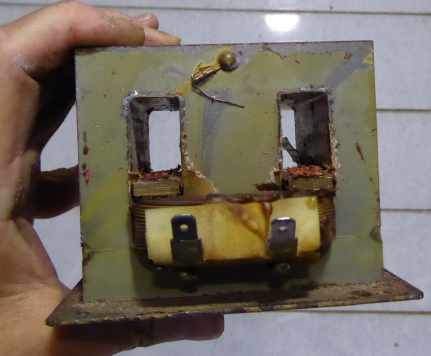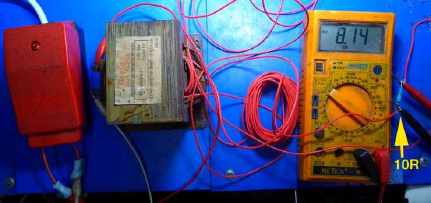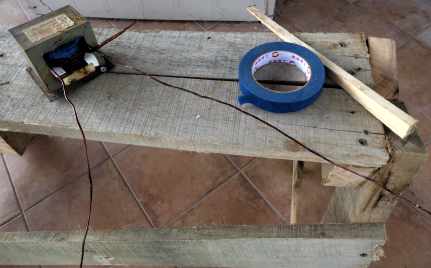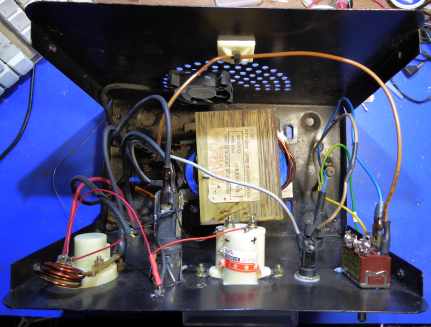Car Battery Charger RepairMy car battery charger had melted its fuseholder and switch so I ordered new parts. The heavy duty fuseholder and switch arrived so I spent a couple of hours filing the front panel and fitting the fuseholder, switch and a voltmeter - because it was there (I'd ordered it via eBay because I thought it might come in handy one day). Job finished! I switched it on for a final check and discovered that it produces only ten volts. The transformer is faulty. Darn!
So now I needed to find a really cheap battery charger transformer rated at 15 - 16v RMS and capable of supplying at least 10 Amps. Price for a new one is ridiculous - they must wind them with gold wire! As an alternative, I had removed the secondary (high-voltage) winding from a (free, scrap,) microwave oven transformer with the intention of winding thick wire to create a low-voltage, high-current output.
I put the transformer in a vise and hacksawed though the high-voltage secondary winding (very thin wire).
Then I used a metal rod to hammer out the blocks of copper wire remaining inside.
The transformer (below) now has only the primary winding intact.
Well, today, I got around to winding ten turns of thin, multistrand, insulated copper wire onto it for testing. The ten turns produced an open-circuit voltage of 8.55 volts RMS. Connecting a 10 Ohm resistor across the output, drawing somewhat less than 1 Amp, caused the voltage to fall to 8.14 volts RMS (because the test wire is long and thin). | ||
| Tim wrote: That's not an 8 watt resistor. You had better put it in a glass of water if you are running the test for long. I know. I went to university. ;-) The test was extremely brief. Just long enough to photograph the voltage display. And I removed the resistor with pliers. I wasn't going to touch it! | ||
| The target voltage is 16 vRMS for the battery charger (to accommodate losses in a bridge rectifier) so I'm going to say that one turn of thick wire will give me 0.8 volts under load (charging). Twenty turns, therefore, will produce 16 volts RMS. If it turns out that I need fewer turns, it's easy to remove one or two. Better to start with too many. One turn is 23cm long so I'll need 460cm plus tails - say 5 metres. Yes, those crocodile clips are carrying live 230 volts AC to the bare transformer terminals. Don't do this at home! With a 5 metre length of solid, enamelled copper wire, I'll need plenty of outdoor space to wind it. In normal manufacturing, the wire would be wound onto a cardboard or "Nomex" core, which is then slipped onto the "E" shaped transformer laminations before the other laminations are added. This method isn't possible with the welded-lamination microwave oven transformer that already has a primary winding. So I'll have to use the tedious "threading a needle" method. (Later, if I can find another transformer, I plan to convert it into a spot-welder. This requires just a couple of turns of very thick copper wire.) | ||
|
Here's the transformer screwed to a heavy bench so it can't move while I'm pulling the thick, solid, enamelled copper wire through it. | ||
|
|
And the finished transformer fitted into the battery charger housing. It had a not very accurate ammeter and I added a voltmeter. With a 25 Watt 1 Ohm resistor connected, the voltmeter reads 13 volts and the ammeter displays a very optimistic 30 Amps! (Work it out from Ohm's Law. A 1 Ohm resistor with 13 volts across it will be passing 13 Amps of current, not 30.) There's a coil of wire acting as a shunt for the meter so I might reduce that in length until the meter reads correctly. | |
|
. | ||
| Send this page address - CLICK HERE - to a friend ! | ||
